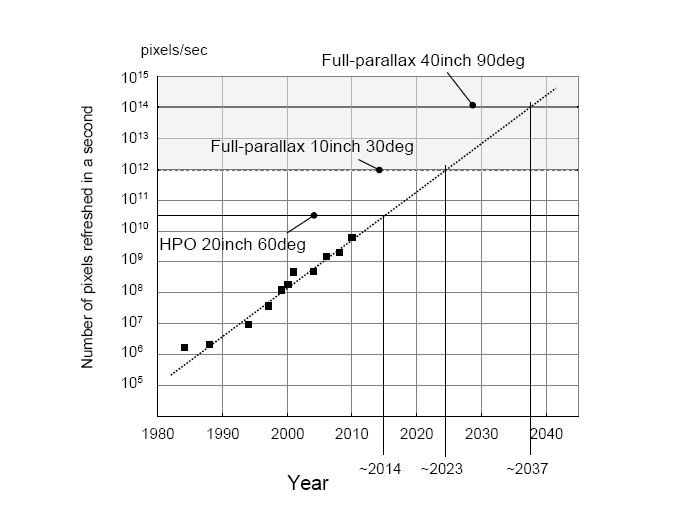Japanese / English
ホログラフィックテレビはいつ実現する?
FUTURE TRENDS OF HOLOGRAPHIC 3D DISPLAY
When can we see electronic display of holography?
Masahiro Yamaguchi
Global Scientific Information and Computing Center,
Tokyo Institute of Technology
What is the future of holographic 3D display?
For holographic 3D display huge amount of data must be presented. In hardcopy 3D display it is possible to sequentially record such huge information, but electronic holographic display, or electro-holography requires much more efforts to be realized. The information necessary for holographic display is quite huge, the advancements are needed in both processing and displaying such huge information. Especially the spatio-temporal resolution of display device is a critical issue. A well-known method to reduce the data amount is discarding vertical parallax, namely, horizontal-parallax only (HPO) hologram approach. However, the specifications of recent autostereoscopic 3D displays have been amazingly advanced, and their image quality is becoming nearly comparable to HPO hologram. So, what is a unique feature of holography? What kind of 3D image can we expect for holography?One of the important points is visual fatigue, caused by the inconsistent depth cues between binocular disparity and the focus in binocular stereo or multi-view 3D displays. Holography is expected to solve the problem, since all the depth cues are satisfied. In addition, it is known that holography can reproduce realistic 3D image of very deep 3D scene. Image display of deep 3D scene is affected by the image blur in conventional autostereoscopic displays such as lenticular or parallax-barrier displays. Therefore, one of the visions of the future of holographic 3D display is a display of high-resolution, deep 3D scene; another world is appeared beyond the window of display, though some object can be appeared in near side, such as another room, office, city, or natural scene. An observer can see the display not only from a certain distance from the display plane, but from the close proximity of the display. This fact also leads an additional feature of holography; large image can be observed even in small display, if viewing from very close to the display.
What specifications are required to display device for electronic display of holography?
According to previous studies on the requirements to the holographic display device, the specification of a holographic display can be roughly determined by 1) hologram size (D) and 2) viewing angle or the angle of viewing field (q). We can employ an optical system that magnifies the image size, but if we magnify the image size of hologram, the viewing angle becomes small. In fact, the product Dq is constant if the number of pixels in one dimension, referred to N, is fixed, or, approximately D q = N l. Therefore the most critical requirement is the number of pixels. For example, to reproduce a human subject in a virtual window of 2.0 m height located at 1.0 m from the display, the viewing angle should be almost 90 degrees. In case of bust shot it becomes about 30 degrees. If the display size is 10 inch diagonal (aspect ratio 4:3), and the viewing angle is 30 degrees and full-parallax, the number of pixels becomes about 207,000×155,000. Assuming 30Hz refresh rate, then the total number of pixels required for this display is almost 9.6×1011 pixels/second. Higher specification one, 40 inch diagonal display (aspect ratio 16:9) with viewing angle 90 degrees, requires 2,500,000×1,400,000 pixels and 1.0×1014 pixels/second in 30Hz refresh rate. In short, a display device that is capable of presenting about 1012 ~ 1014 pixels/second is required for holographic display.
When can we see the holographic display?
Let us briefly take a look at the history of display devices for non-military purposes. In 1988, Epson commercialized liquid crystal television of 320×220 pixels, 30 f/s, which corresponds to 2.1×106 pixels/second. In mid 1990’s, VGA (640×480 pixels) display which is almost equivalent to NTSC television was commonly available. High-definition (1920×1080 pixels, 60 f/s 1.2×108 pixels/second) liquid crystal display (LCD) was presented around 1999, 4k in mid 2000’s, and recently 8k LCoS projector has been announced; 8192×4320 pixels, 60 f/s 2.1×109 pixels/second. High-speed MEMS display, for example digital micromirror device (DMD) of 1920×1080 pixels, 24 kHz (binary image) is now available. Fig. 1 shows the plot of the progress of the display devices. We can see the trend similar to the Moore’s law. Although this is quite rough estimate and there is no evidence that support the validity of future extrapolation, the discussion here suggest that in mid-2020’s, the device suitable for holographic display will be available.

Fig.1 The trend of spatio-temporal resolution (pixels/ second) of display devices from late 1980’s to 2010. Square dots represent examples of commercialized or prototyped display devices. Horizontal lines denote the resolutions required for holographic displays of several specifications. Predicted line was hand-written.
This figure was created as an effort of Working Group for Holography Roadmap, in Holographic Display Artists and Engineers Club (HODIC)
Reference
Masahiro Yamaguchi, “Ray-based and wavefront-based holographic displays for high-density light-field reproduction”, Proc. SPIE 8043, 804306 (2011); http://dx.doi.org/10.1117/12.884500
